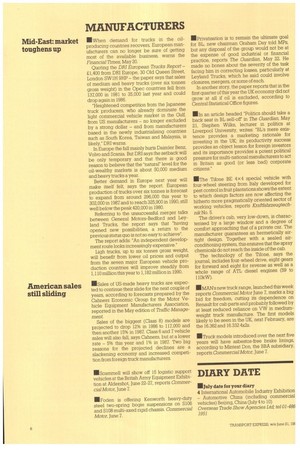Mid-East: market toughens up
Page 20

If you've noticed an error in this article please click here to report it so we can fix it.
"'When demand for trucks in the oilproducing countries recovers, European manufacturers can no longer be sure of getting most of the available business, warns the Financial Times, May 20.
Quoting the DRI European Trucks Report £1,400 from DRI Europe, 30 Old Queen Street, London SW1H 9HP the paper says that sales of medium and heavy trucks (over six tonnes gross weight) in the Opec countries fell from 137,000 in 1981 to 35,000 last year and could drop again in 1986.
"Heightened competition from the Japanese truck producers, who already dominate the light commercial vehicle market in the Gulf, from US manufacturers no longer excluded by a strong dollar and from manufacturers based in the newly industrialising countries such as South Korea, Taiwan and Malaysia, is likely," DRI warns.
In Europe the fall mainly hurts Daimler Benz, Volvo and Scania. But DRI says the setback will be only temporary and that there is good reason to believe that the "natural" level for the oil-wealthy markets is about 80,000 medium and heavy trucks a year.
Better demand in Europe next year will make itself felt, says the report. European production of trucks over six tonnes is forecast to expand from around 296,000 this year to 302,000 in 1987 and to reach 325,900 in 1990, still well below the peak 420,000 in 1980.
Referring to the unsuccessful merger talks between General Motors-Bedford and Leyland Trucks, the report says that "having opened new possibilities, a return to the previous status quo is not so easy to achieve".
The report adds: "An independent development route looks increasingly expensive."
Ligh trucks, up to six tonnes gross weight, will benefit from lower oil prices and output from the seven major European vehicle production countries will improve steadily from 1,110 rnillion this year to 1,182 million in 1990.
III Sales of US-made heavy trucks are expected to continue their slide for the next couple of years, according to forecasts prepared by the Cahners Economic Group for the Motor Vehicle Equipment Manufacturers Association, reported in the May edition of Traffic Management Sales of the biggest (Class 8) models are projected to drop 12% in 1986 to 117,000 and then another 15% in 1987. Class 6 and 7 vehicle sales will also fall, says Cahners, but at a lower rate 5% this year and 1% in 1987. Two big reasons for the projected declines are a slackening economy and increased competition from foreign truck manufacturers.
IIScammell will show off 15 logistic support vehicles at the British Army Equipment Exhibition at Aldershot, June 22-27, reports Commercial Motor, June 7.
Nfroden is offering Kenworth heavy-duty steel two-spring bogie suspensions on S106 and S108 multi-axed rigid chassis. Commercial Motor, June 7. N Privatisation is to remain the ultimate goal for BL, new chairman Graham Day told MPs, but any disposal of the group would not be at the expense of good industrial or financial practice, reports The Guardian, May 22. He made no bones about the severity of the task facing him in correcting losses, particularly at Leyland Trucks, which he said could involve closures, mergers, or some of each.
In another story, the paper reports that in the first quarter of this year the UK economy did not grow at all if oil is excluded, according to Central Statistical Office figures.
Min an article headed "Politics should take a back seat in BL sell-off in The Guardian, May 21, Stephen Wilks, lecturer in politics at Liverpool University, writes: "BL's mere existence provides a marketing rationale for investing in the UK; its productivity success provides an object lesson for foreign investors and its importance provides a potent political pressure for multi-national manufacturers to act in Britain as good (or less bad) corporate citizens."
INThe Tifone BE 4 x 4 special vehicle with four-wheel steering from Italy developed for pest control in fruit plantations shows the extent to which design factors are now affecting the hitherto more pragmatically oriented sector of working vehicles, reports ICraittahrzeugtechnik No. 5.
The driver's cab, very low-down, is characterised by a large window and a degree of comfort approaching that of a private car. The manufacturer guarantees an hermetically airtight design. Together with a sealed airconditioning system, this ensures that the spray chemicals do not reach the inside of the cab.
The technology of the Tifone, says the journal, includes four-wheel drive, eight gears for forward and eight for reverse as well as a whole range of ATL diesel engines (59 to 110kW).
UMAN's new truck range, launched this week reports Commercial Motor June 7, marks a big bid for freedom, cutting its dependence on Renault for cab parts and probably followed by at least reduced reliance on VW in mediumweight truck manufacture. The first models likely to be seen in the UK, next February, are the 16.362 and 16.332 4x2s.
IN Truck models introduced over the next five years will have asbestos-free brake linings, according to Mintext Don, the BBA subsidiary, reports Commercial Motor, June 7.






















































































